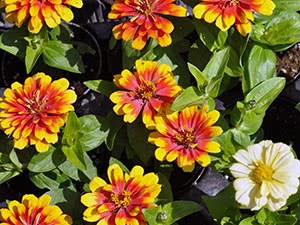 Zinnia (лат. Zinnia) belongs to the genus of herbaceous and shrubby perennials in the Asteraceae family, native to South Mexico, named after the pharmacologist and botanist Johann Gottfried Zinn from Göttingen, who being a director of the Botanic garden supplied Carl Linnaeus with the herbarium for research. The Aztecs cultivated zinnia from 1500, and in Europe it appeared in the 18th century, immediately becoming a favorite ornament of gardens and aristocratic receptions.
Zinnia (лат. Zinnia) belongs to the genus of herbaceous and shrubby perennials in the Asteraceae family, native to South Mexico, named after the pharmacologist and botanist Johann Gottfried Zinn from Göttingen, who being a director of the Botanic garden supplied Carl Linnaeus with the herbarium for research. The Aztecs cultivated zinnia from 1500, and in Europe it appeared in the 18th century, immediately becoming a favorite ornament of gardens and aristocratic receptions.
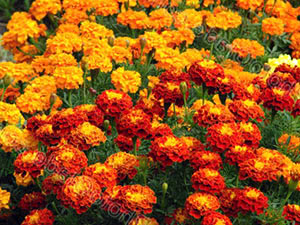 Marigold (lat. Tagetes) is a genus of perennial and annual plants belonging to the family of Asteraceae or Compositae. This plant is native to South and Central America. They have long been used in the rituals of local Indian tribes, as well as for treatment of various diseases. In Europe marigolds were brought in the 16th century and were the first overseas flowers in Russia. The marigold flower was named by Karl Linnaeus in honor of Tagez, the Etruscan demigod, the grandson of Jupiter, famous for his beauty and gift of the soothsayer.
Marigold (lat. Tagetes) is a genus of perennial and annual plants belonging to the family of Asteraceae or Compositae. This plant is native to South and Central America. They have long been used in the rituals of local Indian tribes, as well as for treatment of various diseases. In Europe marigolds were brought in the 16th century and were the first overseas flowers in Russia. The marigold flower was named by Karl Linnaeus in honor of Tagez, the Etruscan demigod, the grandson of Jupiter, famous for his beauty and gift of the soothsayer.
 Hyacinth (lat. Hyacinthus) is a genus of bulbous perennials in the family of Asparagaceae, although it used to belong to a separate family of Hyacinthaceae and was formerly classified in the lily family Liliaceae. The name of the flower is translated from the Greek language and means “flower of rains”. The flower was named after the hero of the ancient Greek myth: in those days there was a beautiful young man, Hyacinth, the son of King of Sparta, a young friend of the god Apollo who often descended from heaven and taught Hyacinth to throw a discus.
Hyacinth (lat. Hyacinthus) is a genus of bulbous perennials in the family of Asparagaceae, although it used to belong to a separate family of Hyacinthaceae and was formerly classified in the lily family Liliaceae. The name of the flower is translated from the Greek language and means “flower of rains”. The flower was named after the hero of the ancient Greek myth: in those days there was a beautiful young man, Hyacinth, the son of King of Sparta, a young friend of the god Apollo who often descended from heaven and taught Hyacinth to throw a discus.
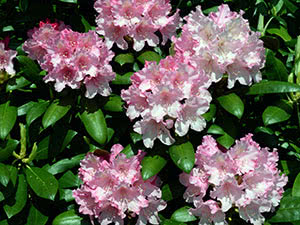 Rhododendron plant (lat. Rhododendron) is a genus of semi-deciduous, deciduous and evergreen trees and shrubs in the heath family that according to various sources contains from 800 to 300 species, including such popular indoor plants as azaleas that are nicknamed “indoor rhododendrons”. The word “rhododendron” is made up of two parts: “rhodon” that means “rose”, and “dendron” that means “tree”. So literally rhododendron is a rosewood or a tree with roses. And azaleas really look like roses. In nature rhododendrons mainly grow in the Northern Hemisphere – in Southern China, Japan, the Himalayas, North America and Southeast Asia.
Rhododendron plant (lat. Rhododendron) is a genus of semi-deciduous, deciduous and evergreen trees and shrubs in the heath family that according to various sources contains from 800 to 300 species, including such popular indoor plants as azaleas that are nicknamed “indoor rhododendrons”. The word “rhododendron” is made up of two parts: “rhodon” that means “rose”, and “dendron” that means “tree”. So literally rhododendron is a rosewood or a tree with roses. And azaleas really look like roses. In nature rhododendrons mainly grow in the Northern Hemisphere – in Southern China, Japan, the Himalayas, North America and Southeast Asia.
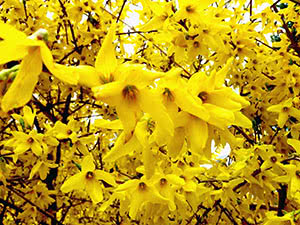 Forsythia plant (lat. Forsythia) is a genus of small trees and bushes of the olive family (Oleaceae), blooming with bright yellow flowers in early spring. The genus of forsythia is very ancient, and this is confirmed by the spread of its natural habitat: six species of forsythia grow in East Asia (Japan, Korea, China), in Europe forsythia flower is represented only by European forsythia (Forsythia europaea) that mainly grows in the Balkans, although you can see forsythia flowering in the middle of March in Germany.
Forsythia plant (lat. Forsythia) is a genus of small trees and bushes of the olive family (Oleaceae), blooming with bright yellow flowers in early spring. The genus of forsythia is very ancient, and this is confirmed by the spread of its natural habitat: six species of forsythia grow in East Asia (Japan, Korea, China), in Europe forsythia flower is represented only by European forsythia (Forsythia europaea) that mainly grows in the Balkans, although you can see forsythia flowering in the middle of March in Germany.
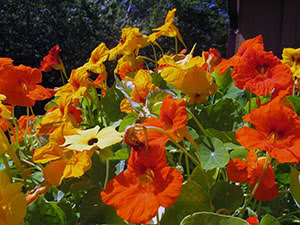 Nasturtium, or tropaeolum, is a herbaceous plant in the family Tropaeolaceae that includes about 90 species. The nasturtium plant comes from South and Central America, but in our climate zone it also settled long ago since it is characterized by unpretentiousness and has good healing properties and great taste qualities. The main thing is that the flower of nasturtium decorates even the most refined garden with its long-lasting flowering. Tropaeolum is derived from a Greek word “tropaion” meaning “trophy”.
Nasturtium, or tropaeolum, is a herbaceous plant in the family Tropaeolaceae that includes about 90 species. The nasturtium plant comes from South and Central America, but in our climate zone it also settled long ago since it is characterized by unpretentiousness and has good healing properties and great taste qualities. The main thing is that the flower of nasturtium decorates even the most refined garden with its long-lasting flowering. Tropaeolum is derived from a Greek word “tropaion” meaning “trophy”.
 This haiku of Matsuo Basho, the Japanese poet, is dedicated to ipomea plant, or water convolvulus. It is the most numerous genus of flowering plants in the family Convolvulaceae. There are more than five hundred species in this genus. Its representatives grow in tropical and subtropical regions of the world and the genus comprises perennial and annual plants, bushes, trees and lianas. In the genus of ipomea there are even representatives of food crops – sweet potato and water spinach. The name “ipomea” is derived from two Greek words: “ips” means “worm” and “homoios” means “similar”. So the name means “worm-like” and this definition refers to the rhizome of perennial plants of the ipomea genus. In floriculture, lianas of this genus are mostly used.
This haiku of Matsuo Basho, the Japanese poet, is dedicated to ipomea plant, or water convolvulus. It is the most numerous genus of flowering plants in the family Convolvulaceae. There are more than five hundred species in this genus. Its representatives grow in tropical and subtropical regions of the world and the genus comprises perennial and annual plants, bushes, trees and lianas. In the genus of ipomea there are even representatives of food crops – sweet potato and water spinach. The name “ipomea” is derived from two Greek words: “ips” means “worm” and “homoios” means “similar”. So the name means “worm-like” and this definition refers to the rhizome of perennial plants of the ipomea genus. In floriculture, lianas of this genus are mostly used.
 Many plant growers tried to grow roses from cuttings, but not all of them were successful. We are going to tell how to grow roses from cuttings and hope that this knowledge will help you become more successful in breeding these truly royal flowers. Propagation of roses by cuttings guarantees a much more reliable result than grafting or seed propagation due to its simplicity and the opportunity to be carried out at any time of the year since not only spring shoots of a rose bush, but also the stems of roses from a bouquet gifted to you can be used as cuttings.
Many plant growers tried to grow roses from cuttings, but not all of them were successful. We are going to tell how to grow roses from cuttings and hope that this knowledge will help you become more successful in breeding these truly royal flowers. Propagation of roses by cuttings guarantees a much more reliable result than grafting or seed propagation due to its simplicity and the opportunity to be carried out at any time of the year since not only spring shoots of a rose bush, but also the stems of roses from a bouquet gifted to you can be used as cuttings.
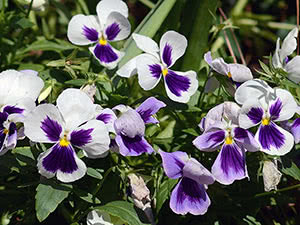 Viola plant (lat. Viola) belongs to the genus in the family of Violaceae, the representatives of which grow mainly in mountainous areas and places with a moderate climate of the Northern Hemisphere and number from four to seven hundred species according to various sources. Some of the violas are endemic to the South American Andes, some of them occur in the subtropics of Brazil, the tropics of South Africa, Australia, the Hawaiian Islands and New Zealand. The common name of viola is a pansy. The violet-viola has long been popular. About 2,500 years ago ancient peoples inhabiting the territory of Europe weaved the flower into festive garlands and wreaths, decorating the rooms for celebrations. Sweet viola was the first viola that was introduced in the culture and it was followed by mountain viola.
Viola plant (lat. Viola) belongs to the genus in the family of Violaceae, the representatives of which grow mainly in mountainous areas and places with a moderate climate of the Northern Hemisphere and number from four to seven hundred species according to various sources. Some of the violas are endemic to the South American Andes, some of them occur in the subtropics of Brazil, the tropics of South Africa, Australia, the Hawaiian Islands and New Zealand. The common name of viola is a pansy. The violet-viola has long been popular. About 2,500 years ago ancient peoples inhabiting the territory of Europe weaved the flower into festive garlands and wreaths, decorating the rooms for celebrations. Sweet viola was the first viola that was introduced in the culture and it was followed by mountain viola.
 Dragon flowers, or snapdragon, or antirrhinum (lat. Antirrhinum) is a genus of herbaceous plants in the family Plantaginaceae that involves about 50 species of perennials including trailing ones. It is native to the warm climate zones and grows mainly in North America. The Russians call this plant "doggies", the British – "snapdragon", the French – "wolf mouth", and the Ukrainians – "little mouths." Its name was derived from the Greek word "antirrinum" that means "nose-like". In Ancient Greek mythology, the first Hercules’ labour was to kill the Nemean lion that was famous for its ferocity and invulnerability. The Goddess Flora gifted Hercules with a beautiful flower that she created in honor of his victory and that she called a "lion's mouth." Since then, in Greece it has become a tradition to gift snapdragons to heroes.
Dragon flowers, or snapdragon, or antirrhinum (lat. Antirrhinum) is a genus of herbaceous plants in the family Plantaginaceae that involves about 50 species of perennials including trailing ones. It is native to the warm climate zones and grows mainly in North America. The Russians call this plant "doggies", the British – "snapdragon", the French – "wolf mouth", and the Ukrainians – "little mouths." Its name was derived from the Greek word "antirrinum" that means "nose-like". In Ancient Greek mythology, the first Hercules’ labour was to kill the Nemean lion that was famous for its ferocity and invulnerability. The Goddess Flora gifted Hercules with a beautiful flower that she created in honor of his victory and that she called a "lion's mouth." Since then, in Greece it has become a tradition to gift snapdragons to heroes.
